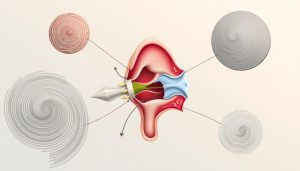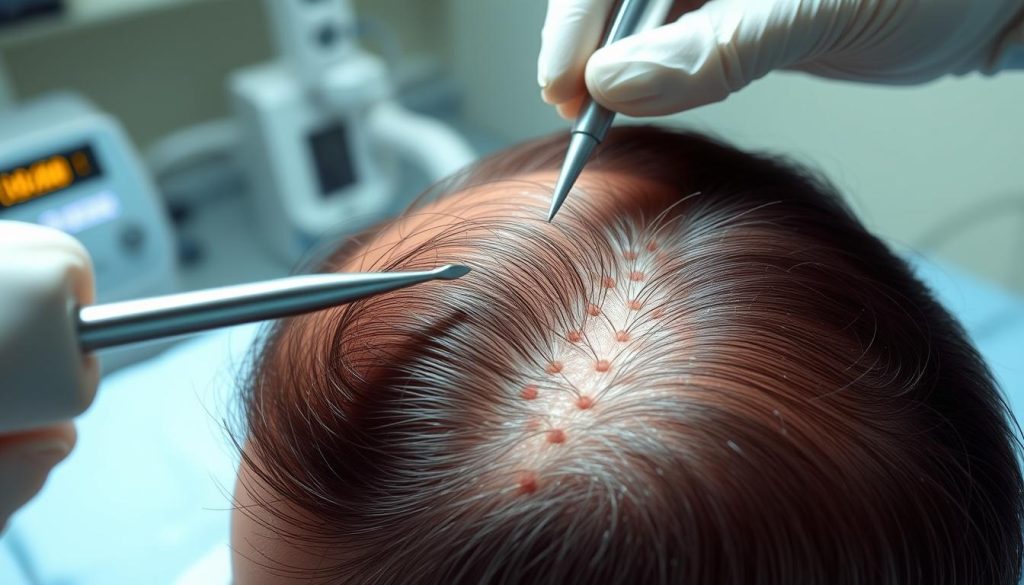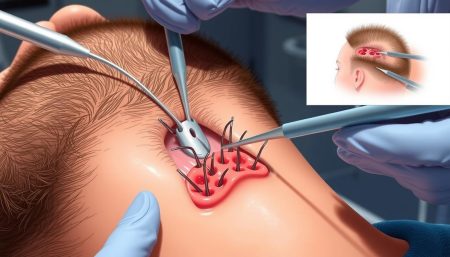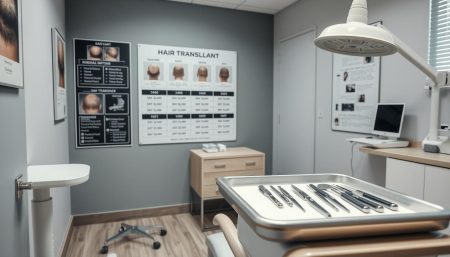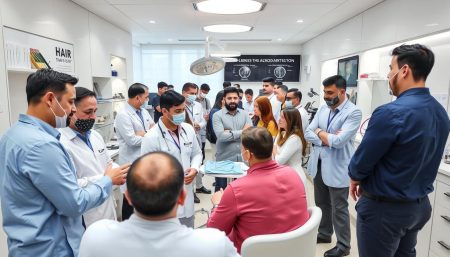Hair loss can really affect how we feel about ourselves. Luckily, there’s a new way to tackle it: the FUE hair transplant. This method is changing how we treat hair loss, giving natural results with little to no scarring.
FUE, or Follicular Unit Extraction, is a leading-edge way to restore hair. It takes hair follicles from a donor area and moves them to thin or bald spots. This method is loved for its accuracy and natural-looking hairline.
With advancements in hair loss treatments, FUE has become a top choice. It’s known for being gentle and quick to heal, making it a great option for a lasting fix. Its success comes from mimicking natural hair growth, making the results almost invisible.
Understanding FUE Hair Transplant Technology
Hair restoration has made huge strides, with FUE leading the way. This method is less invasive and gives a natural look. It’s a big step forward in hair transplant technology.
The Evolution of Hair Transplant Techniques
Hair transplantation has evolved a lot. Old methods looked unnatural. Then, FUT improved things but left scars. FUE, thanks to trichology, is the latest breakthrough.
How FUE Differs from Traditional Methods
FUE takes individual follicles from the donor area. This means no big scalp strip and less scarring. It also means a quicker recovery and a more natural look.
Modern Equipment and Technology Used
FUE uses top-notch gear for precision and speed. Microscopes help pick and remove follicles carefully. Automated tools and special devices ensure the hair grafts are safe.
Trichology in FUE tech boosts graft survival and results. This science-based approach keeps improving hair restoration. It offers new hope for those fighting hair loss.
Candidates for FUE Hair Transplant Procedures
FUE hair transplants offer hope for those struggling with hair loss. This advanced technique can address various forms of alopecia, including the common androgenetic alopecia. Ideal candidates typically have sufficient donor hair and maintain realistic expectations about the outcome.
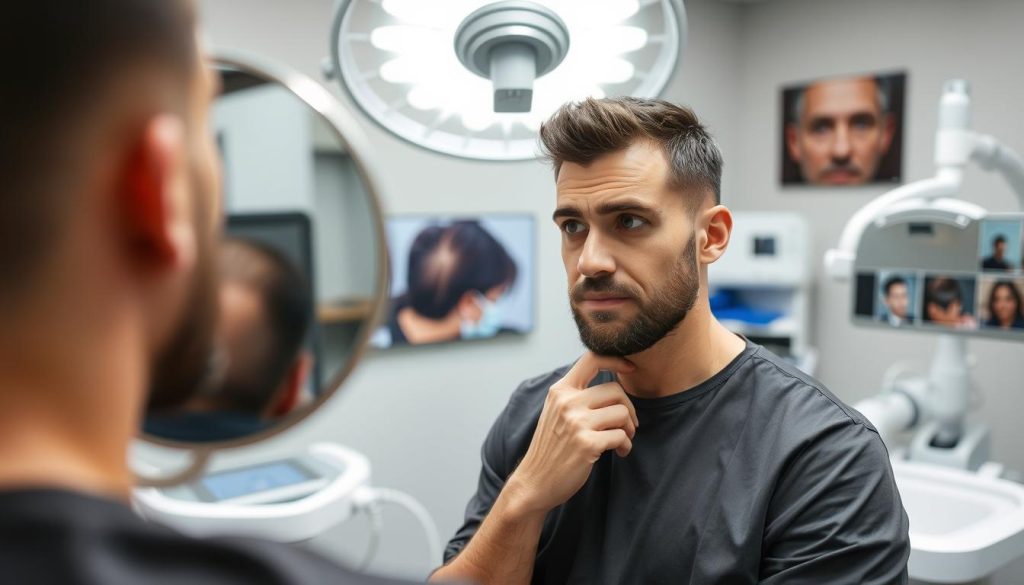
Age is a key factor in determining suitability for FUE. While there’s no strict age limit, doctors often recommend waiting until hair loss has stabilised. This is usually in one’s late twenties or early thirties. Overall health is equally important, as certain medical conditions may affect healing and results.
FUE excels in hairline restoration for both men and women. It can recreate natural-looking hairlines, addressing receding hairlines in men and thinning along the part line in women. The procedure’s versatility allows for targeted treatment of specific areas affected by hair loss.
- Sufficient donor hair availability
- Realistic expectations
- Stable pattern of hair loss
- Good overall health
- No contraindicated medical conditions
Not everyone is an ideal candidate for FUE. Factors that might disqualify someone include extensive hair loss with limited donor hair, certain scalp conditions, or unrealistic expectations about the results. A thorough consultation with a qualified specialist is essential to determine if FUE is the right choice for your specific case of alopecia or hairline restoration needs.
The Science Behind Follicular Unit Extraction
Follicular unit extraction is a modern hair transplant method. It uses science to pick the right donor area and extract grafts carefully. This ensures natural-looking results.
Donor Area Selection and Management
Choosing the right donor area is key for follicular unit extraction. Doctors usually pick the back and sides of the head. These areas have hair that’s less likely to fall out.
They map out the area to spread the hair evenly. This helps avoid big scars.
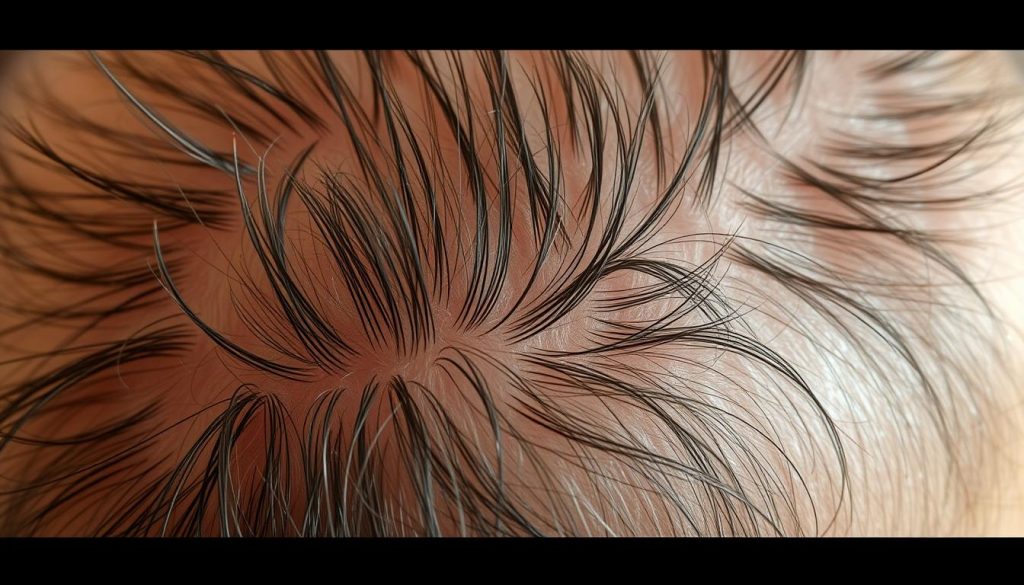
Graft Extraction Techniques
There are a few ways to get hair grafts:
- Manual punch extraction
- Motorised extraction
- Robotic-assisted extraction
Each method tries to keep the grafts alive by causing less damage to the follicles.
Preservation of Hair Follicles
Keeping the grafts alive is very important. They are stored in a special solution. This keeps them healthy.
The temperature and humidity are kept just right. This helps the grafts survive longer.
| Preservation Method | Temperature Range | Max Storage Time |
|---|---|---|
| Chilled Saline Solution | 4-8°C | 6-8 hours |
| Hypothermosol | 2-8°C | Up to 5 days |
| HypoThermosol FRS | 2-8°C | Up to 7 days |
By following these scientific steps, follicular unit extraction can give great results. Patients get natural-looking hair again.
Benefits and Advantages of FUE Treatments
FUE hair transplant is a top choice for treating hair loss. It’s a modern method that beats old ways, making it a favourite for those wanting to get their hair back.
One big plus of FUE is it causes little scarring. Unlike old methods, FUE takes out single follicles, leaving tiny spots. These spots are so small, you can’t see them easily, even when your hair is short.
FUE also means you can get back to your life quickly. Most people can start doing normal things again in just a few days. They feel less pain and heal faster.
- Natural-looking results
- Versatility in treating various areas
- Improved self-confidence
- Enhanced quality of life
FUE isn’t just for the scalp. It works well for eyebrows and beards too. This means it can tackle hair loss all over your face.
“FUE hair transplant has transformed my life. The results are incredibly natural, and I feel more confident than ever.” – Sarah, FUE patient
Getting your hair back with FUE can really lift your mood. Many people say they feel younger and more confident after it.
| Aspect | FUE Hair Transplant | Traditional Methods |
|---|---|---|
| Scarring | Minimal | Visible linear scar |
| Recovery Time | 3-5 days | 10-14 days |
| Natural Look | High | Moderate |
| Versatility | Scalp, eyebrows, beard | Primarily scalp |
Pre-procedure Assessment and Planning
Before starting a hairline restoration, patients go through a detailed assessment and planning. This stage is key to achieving the best results and managing expectations.
Medical Evaluation Requirements
A detailed medical check is vital to see if a patient is right for the treatment. It looks at health, scalp condition, and any risks. Trichology helps understand hair growth and find the best donor areas.
| Evaluation Component | Purpose |
|---|---|
| Blood Tests | Check for underlying health issues |
| Scalp Examination | Assess hair density and quality |
| Medical History Review | Identify any issues that might stop the treatment |
Hairline Design Consultation
During the consultation, experts work with patients to design a natural hairline. They consider face shape, age, and what the patient likes. They might use advanced tech to show what the hairline could look like.

Treatment Timeline Planning
A realistic timeline is set based on hair loss and what the patient wants. For big changes, more than one session might be needed. The plan covers everything from before the treatment to aftercare for the best healing and growth.
This careful planning helps patients feel confident about their hairline restoration. They know their unique needs and goals are being met.
The FUE Procedure Step by Step
Follicular unit extraction (FUE) is a detailed process that needs skill and precision. It starts with preparing the scalp. The donor area is trimmed short to make it easier to extract individual follicular units.
Then, local anaesthesia is given to keep the patient comfortable. The surgeon uses special micro-punches to carefully take out individual follicles from the donor area, usually the back of the head. These grafts are sorted and prepared for implantation.
The recipient area is then prepared. Tiny incisions are made to fit the harvested follicles. The surgeon carefully places each graft, focusing on the natural direction and angle of hair growth for a natural look.
| Procedure Step | Duration | Key Focus |
|---|---|---|
| Scalp Preparation | 30 minutes | Trimming and cleaning |
| Anaesthesia Administration | 15 minutes | Patient comfort |
| Graft Extraction | 2-3 hours | Careful follicle removal |
| Graft Preparation | 1 hour | Sorting and hydration |
| Recipient Site Creation | 1 hour | Precise incisions |
| Graft Implantation | 2-3 hours | Accurate placement |
Keeping a high graft survival rate is key throughout the procedure. Grafts are kept moist and handled carefully to ensure they survive. A typical FUE session can take 4-8 hours, depending on the number of grafts needed.
Recovery and Post-operative Care Guidelines
Proper care after your FUE hair transplant is key to success. These guidelines help you get the best results and avoid problems during your treatment.
Immediate Post-procedure Care
Protect the new grafts after your FUE procedure. Sleep with your head up for a few nights to reduce swelling. Clean the areas as your surgeon tells you to.
Avoid touching or scratching the treated spots. This prevents infection and helps healing.
Long-term Maintenance
To keep your hair healthy, stick to a good hair care routine. Use gentle, sulphate-free shampoos and avoid harsh styling products. Regular check-ups with your surgeon are important.
Activity Restrictions
During recovery, avoid certain activities to protect your grafts:
- Don’t do strenuous exercise for at least two weeks
- Avoid direct sun on your scalp for the first month
- Don’t wear hats or helmets until your surgeon says it’s okay
- Stay away from swimming and saunas for at least three weeks
Following these care guidelines boosts your hair transplant success. Remember, it takes time for your new hair to grow and blend with your existing hair.
Expected Results and Timeline
FUE hair transplant results come slowly, giving a natural look over time. Right after the surgery, patients often see a shedding phase for 2-3 weeks. This is normal and shouldn’t worry you.
New hair starts growing 3-4 months after the surgery. By 6 months, about 60% of the hair will have grown. The full effects of the fue hair transplant show up between 12-18 months.
- Individual hair characteristics
- Post-operative care adherence
- Overall health and nutrition
- Age and extent of hair loss
Those with mild to moderate hair loss see the best results. People with more hair loss might need more than one session. Always talk about what you can expect with your surgeon.
“FUE hair transplants can transform not just your appearance, but your confidence. The key is patience during the growth process.”
It’s important to keep up with your surgeon’s appointments to check on your progress. Remember, fue hair transplant doesn’t stop hair loss forever. You need to keep up with care to keep your new hairline.
Combining FUE with Other Hair Loss Treatments
FUE hair transplants can be made better by adding other treatments. This mix offers a full solution for those wanting the best hair restoration results.
PRP Therapy Integration
PRP therapy is a great match for FUE transplants. It uses your own platelets to boost hair growth and help grafts survive. Injecting PRP into your scalp can lead to quicker healing and thicker hair.
Medication Support Options
Medicines are key in keeping transplanted hair healthy and stopping more loss. Here are some common ones:
- Finasteride: Slows hair loss by blocking DHT
- Minoxidil: Makes hair grow faster and improves scalp blood flow
Scalp Micropigmentation Considerations
Scalp micropigmentation is a non-surgical method that boosts FUE transplant results. It adds pigment to the scalp to make hair look fuller. It’s great for:
- Masking scars from old hair transplants
- Making thinning spots look denser
- Defining a natural-looking hairline
| Treatment | Benefits | Best Combined With FUE |
|---|---|---|
| PRP Therapy | Boosts graft survival, aids healing | During and after transplant |
| Medication | Keeps existing hair, supports new growth | Before and after transplant |
| Scalp Micropigmentation | Enhances density, hides scars | After transplant healing |
Potential Risks and Complications
Fue hair transplant procedures have made great strides. Yet, it’s vital to know about possible risks. Trichology experts stress that picking a skilled surgeon can help avoid problems.
Side effects like swelling and numbness are common. Minor scarring might happen, but it’s usually hard to spot. Rarely, patients could face infection or graft growth issues.
Thanks to trichology and fue advancements, risks have decreased. But, it’s key to know about possible issues:
- Bleeding during or after the procedure
- Allergic reactions to anaesthesia
- Shock loss (temporary shedding of existing hair)
- Unnatural-looking hairline if not properly planned
Talk about your health history with your surgeon. Stick to all pre and post-op advice to lower risk of problems.
| Risk | Frequency | Prevention/Management |
|---|---|---|
| Swelling | Common | Ice packs, prescribed medication |
| Infection | Rare | Proper hygiene, antibiotic treatment if needed |
| Poor graft growth | Uncommon | Skilled surgeon selection, proper aftercare |
| Shock loss | Occasional | Usually temporary, resolves within months |
The success of your fue hair transplant depends on your surgeon’s skill and your aftercare commitment.
Cost Considerations and Investment
Thinking about a FUE hair transplant? It’s key to know the money side. This treatment is a lasting fix but it’s pricey. We’ll look at what affects the cost, if insurance helps, and how you can pay for it.
Pricing Factors
The price of a FUE hair transplant changes based on a few things. These are how much hair you’ve lost, how many grafts you need, and the doctor’s skill. Prices usually fall between £3,000 and £15,000, depending on the case’s complexity.
| Factor | Impact on Cost |
|---|---|
| Number of Grafts | £2-£5 per graft |
| Surgeon’s Experience | 20-50% price variation |
| Clinic Location | Up to 30% difference |
Insurance Coverage
Insurance usually doesn’t pay for FUE hair transplants because they’re seen as cosmetic. But, there might be exceptions for hair loss from injury or illness. Always check with your insurance to see what they cover.
Financing Options
Many clinics have payment plans to help make FUE hair transplants more affordable. These might include medical credit cards or plans set up by the clinic. Some plans let you pay over 12 to 24 months, making it easier to manage the cost.
Even though a FUE hair transplant costs a lot upfront, it’s worth thinking about the long-term benefits. It’s a permanent fix that can save you money on temporary treatments. It also offers big psychological benefits.
Choosing a Qualified FUE Specialist
Finding the right specialist for follicular unit extraction is key to great results. They should have lots of experience with this technique and know a lot about hair health.
When looking for a specialist, think about these important points:
- Qualifications and certifications in hair transplantation
- Years of experience performing FUE procedures
- Before and after photos of previous patients
- Patient testimonials and reviews
- Use of cutting-edge technology and equipment
It’s a good idea to meet with several specialists. This way, you can see who you think is the best. Ask them about their success rates, any possible problems, and how they care for patients after surgery.
A top FUE specialist will also know a lot about hair and scalp health. They can check your scalp, find out why you’re losing hair, and suggest treatments that might help more than just surgery.
“The best FUE specialists combine surgical skill with a holistic understanding of hair and scalp health.”
Choose clinics that use the newest hair restoration technology. This shows they’re serious about giving you the best results. By doing your homework and checking out different specialists, you’ll have a better chance of a successful FUE procedure and lasting hair health.
| Criteria | Importance |
|---|---|
| Experience in FUE | High |
| Trichology knowledge | Medium |
| Technology used | Medium |
| Patient reviews | High |
| Before/after portfolio | High |
Long-term Success and Maintenance Strategies
Looking after your new hair after an FUE transplant is vital for lasting results. Keeping your scalp clean and eating well are essential for hair health. Use gentle, sulphate-free shampoos and conditioners to protect your hair.
If you have alopecia, you might need more hair loss treatments in the future. This is often the case with androgenetic alopecia, where hair loss can continue. Regular visits to your hair specialist help you stay on track with your care plan.
What you do in your daily life also affects your hair. Reducing stress, quitting smoking, and drinking less alcohol can help keep your hairline looking good. Some people find scalp massages and natural oils like coconut or castor oil help with hair growth and strength.
Remember, an FUE transplant is just the start of your hair care journey. By following these tips and keeping in touch with your doctor, you can enjoy your new hair for many years.
FUE Hair Transplant:FAQ
Q: What is FUE hair transplant?
A: FUE stands for Follicular Unit Extraction. It’s a hair transplant method. Here, hair follicles are taken from one area and moved to another. This makes the results look natural and leaves little to no scar.
Q: How does FUE differ from traditional hair transplant methods?
A: Unlike FUT, FUE doesn’t take a strip of scalp. Instead, it takes individual follicles. This means less scarring and a quicker recovery.
Q: Who is an ideal candidate for FUE hair transplant?
A: If you have hair loss due to genetics or other reasons, FUE might be for you. You need enough donor hair and should have realistic hopes. Your health and age also play a part.
Q: What is the expected survival rate of transplanted hair grafts?
A: Most grafts survive, with a success rate over 90%. This is true when skilled surgeons use the right techniques and care after the procedure.
Q: How long does the FUE procedure take?
A: The time needed for FUE depends on how many grafts you need. A session can last from 4 to 8 hours. Sometimes, it’s done over several days for bigger transplants.
Q: What is the recovery time after an FUE hair transplant?
A: Recovery is quick, with most back at work in a week. But, it takes months to a year to see the full results.
Q: Can FUE be combined with other hair loss treatments?
A: Yes, FUE works well with other treatments. This includes PRP therapy, certain medications, and scalp micropigmentation. These can improve your results.
Q: Are there any risks or complications associated with FUE?
A: FUE is mostly safe, but there are risks. These include minor scarring, numbness, swelling, and rare infections or poor growth. Choosing a skilled surgeon can lower these risks.
Q: How much does an FUE hair transplant cost?
A: The cost of FUE varies a lot. It depends on how much hair you need, the number of grafts, and the surgeon’s experience. It’s often pricier than older methods.
Q: How long do FUE hair transplant results last?
A: The transplanted hair usually lasts forever. But, you might keep losing hair elsewhere. This could mean needing more treatments in the future.
Q: Can FUE be used for beard or eyebrow transplants?
A: Yes, FUE can be used for different areas, like beards and eyebrows. It’s a flexible way to restore hair on your face.
Q: How should I choose a qualified FUE specialist?
A: Look for a surgeon trained in FUE. They should have a good success rate and know about hair. Check their work, read what others say, and meet with several experts.











